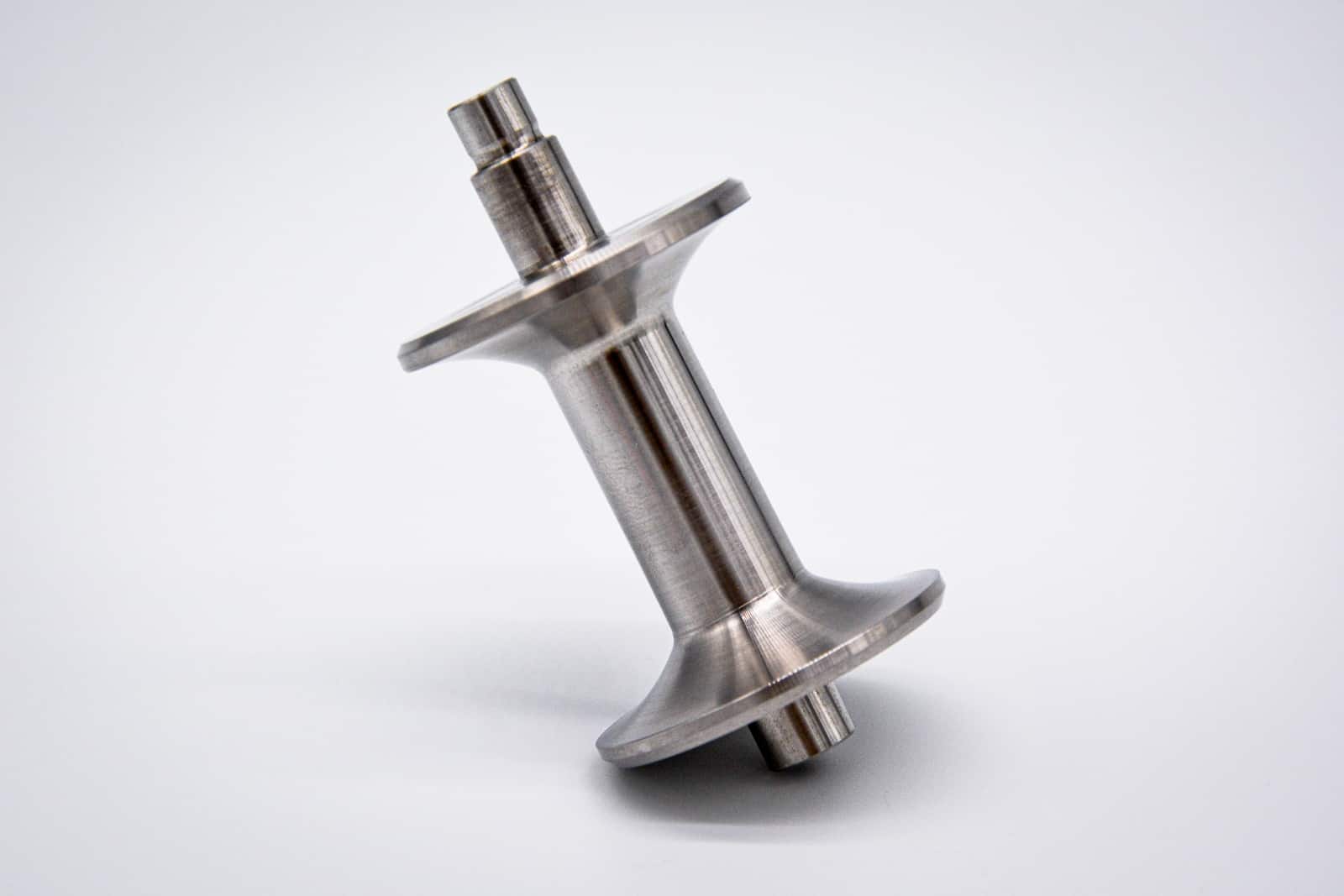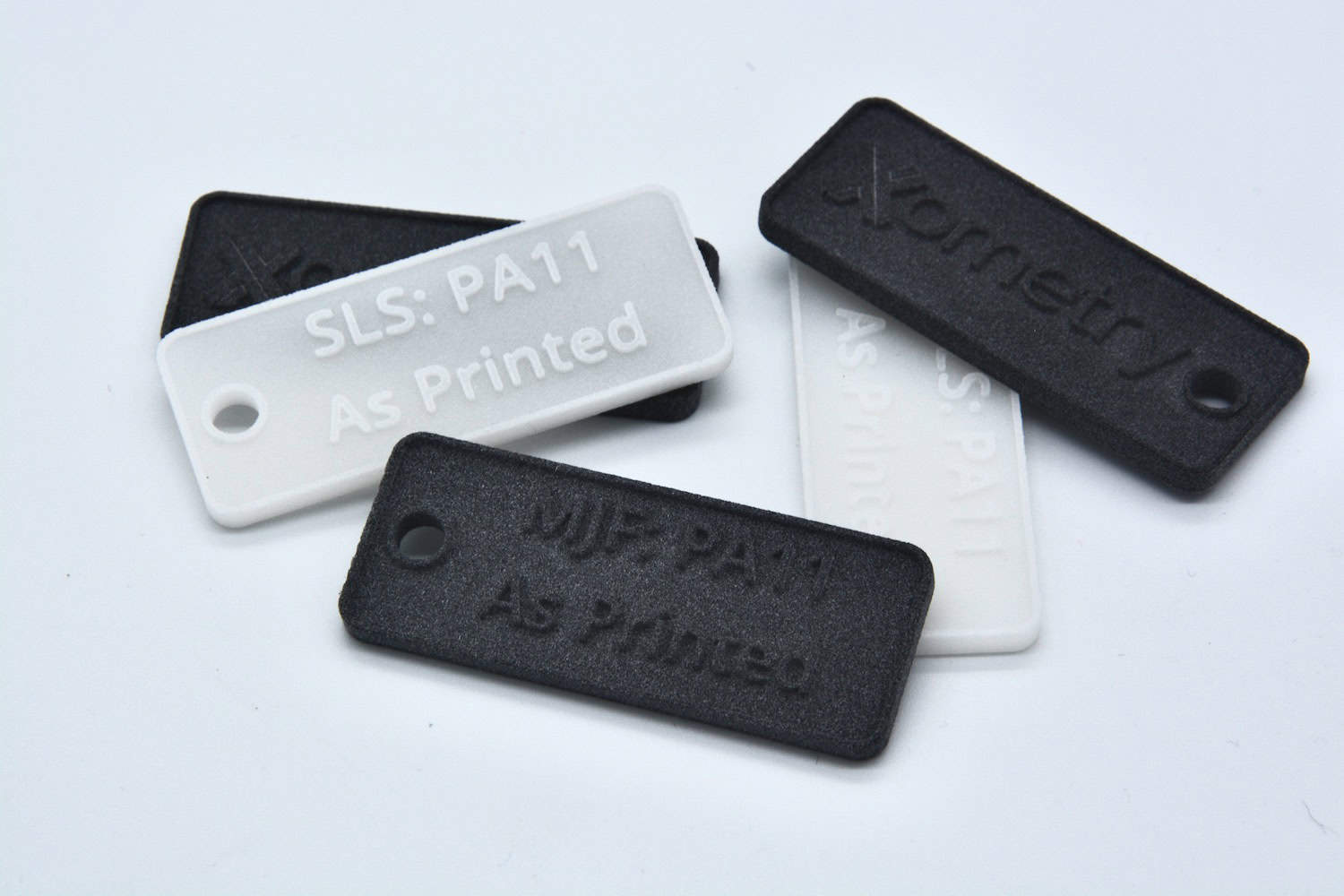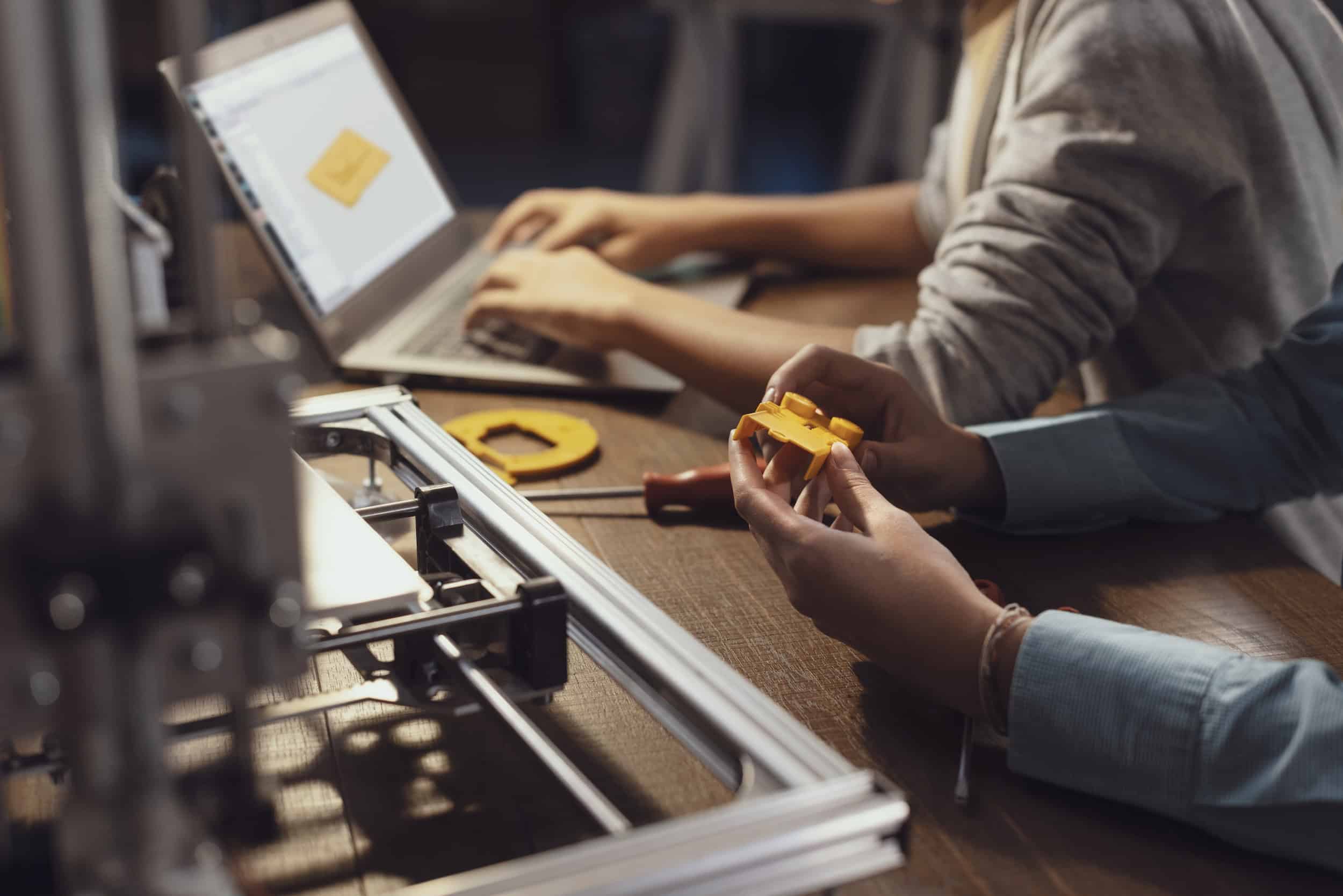Per realizzare prodotti di alta qualità, è fondamentale utilizzare materiali appropriati per la lavorazione CNC. La scelta corretta può farvi risparmiare tempo e denaro. Questo articolo si propone di semplificare il processo di selezione dei materiali adatti alla lavorazione CNC. L’articolo esamina i numerosi materiali che vengono utilizzati per le macchine CNC.
Abbiamo creato un elenco dei materiali per la lavorazione CNC utilizzati da Xometry per produrre pezzi lavorati CNC personalizzati. La maggior parte delle lavorazioni CNC riguarda alluminio, acciaio inox, acciaio, ottone, rame, titanio e plastica rigida.
Leghe di alluminio
Le leghe di alluminio sono il cavallo di battaglia dei componenti lavorati a CNC. Grazie alla loro leggerezza e all’eccellente conducibilità termica, questi materiali massimizzano l’efficienza e facilitano la produzione di pezzi di alta precisione.
L’alluminio può essere trattato termicamente per aumentare la resistenza, mentre altri additivi, come il manganese e il silicio, assicurano la stabilità dimensionale dei pezzi creati con la lavorazione CNC.
Con l’aumento della sua popolarità in tutti i settori industriali, l’alluminio è sempre più utilizzato in applicazioni che vanno dalle cellule aeree strategiche ai componenti delle automobili di tutti i giorni.
Alluminio 2007 / 3.1645 / Al-CuMgPb
Questa è una lega di alluminio a truciolo corto contenente tra il 4,0 e il 5,0% di rame. È molto adatto per alte velocità di lavorazione e ideale per la filettatura. Oltre al rame, contiene anche magnesio e piombo. Questo materiale è comunemente usato per la produzione di parti di macchinari, bulloni e dadi. Tuttavia, il suo contenuto di rame gli conferisce una bassa saldabilità e una bassa resistenza alla corrosione.
- Key features: Excellent machinability • Heat treatable • Low weldability • Low corrosion resistance
- Applications: This material is commonly used to produce machine parts, bolts, and nuts. However, its copper content gives it low weldability and low resistance to corrosion.
- See the datasheet
Alluminio 2017A / 3.1325 / Al-Cu4Mg
Aluminium 2017A / Al-Cu4Mg is an age-hardenable wrought alloy with high strength and excellent ductility. Depending on the required use, it can be heat-treated to obtain a wide variety of qualities. For instance, it could be heat-treated to generate a strong and ductile material, making it ideal for structural applications.
- Key features: Ductile • High strength • Excellent workability
- Applications: Its most common use is in the aerospace industry, namely for manufacturing structural components that require a high strength-to-weight ratio.
- See the datasheet
Alluminio 5083 / 3.3547 / Al-Mg4.5Mn
Aluminium 5083 is a medium-strength, corrosion-resistant alloy. It possesses the strongest strength among the non-heat-treatable alloys, but its usage at temperatures exceeding 65°C is not advised. It is resistant to corrosion and is easy to machine. It can be welded using all usual techniques; however, welding in the heat-affected zone of high-strength alloys is not suggested.
- Key features: Moderate strength • Good machinability • Corrosion resistant • Excellent weldability
- Applications: It is often used in manufacturing sheet metal products such as ducting for HVAC systems, kitchen equipment, and light fittings.
- See the datasheet
Alluminio 6060 / 3.3206 / Al-MgSi
Questa è una lega di alluminio trattabile termicamente a bassa resistenza. Ha una buona resistenza alla corrosione, una buona saldabilità e molto adatto allo stampaggio a freddo. Viene applicato nella produzione di illuminazione, mobili, pavimenti e altre applicazioni di ingegneria senza particolari requisiti di resistenza.
- Key features: Low strength • Heat treatable • Good weldability • Good corrosion resistance
- Applications: It is commonly used to manufacture machined parts for various industries. It is applied in the production of lighting, furniture, flooring, and other engineering applications with no special strength requirement.
- See the datasheet
Alluminio 6061 / 3.3211 / Al-Mg1SiCu
Questa lega contiene magnesio e silicio come suoi principali elementi di lega con tracce di rame. Con una resistenza alla trazione di 180 Mpa, questa è una lega ad alta resistenza ed è molto adatta per strutture altamente stressate in termini di carichi come ponteggi, vagoni ferroviari, componenti di macchinari e del settore aerospaziale.
- Key features: High strength • Good weldability • Corrosion resistant
- Applications: It is also commonly used in forging applications. With a tensile strength of 180 Mpa, this high-strength alloy is very suitable for highly loaded structures such as scaffolds, rail coaches, and machine and aerospace parts.
- See the datasheet
Alluminio 6082 / 3.2315 / Al-Si1Mg
Tipicamente formata per laminazione ed estrusione, questa lega ha una resistenza media con un’ottima saldabilità e conducibilità termica. Ha un’elevata resistenza alle cricche da tensocorrosione. Possiede una resistenza alla trazione che varia da 140 a 330 MPa. È ampiamente impiegato nella costruzione offshore e di container.
- Key features: Good thermal conductivity • Good weldability • High-stress corrosion cracking resistance
- Applications: It is heavily employed in offshore construction and containers.
- See the datasheet
Alluminio 7075 / 3.4365 / Al-Zn6MgCu
Lo zinco è l’elemento di lega principale. Ha un’elevata resistenza (57MPa), tenacità e ottima resistenza alla fatica. La superficie può essere fresata o spazzolata. Ha un’ottima lavorabilità. È ampiamente utilizzato nelle parti strutturali degli aerei.
- Key features: High strength • Tough • Resistant to fatigue • Excellent machinability
- Applications: With a density of only 2.81 g/cm³, it is also one of the lightest alloys in commercial production. It is extensively used in the structural parts of aircraft.
- See the datasheet
Aluminium Alloys Mechanical Properties Comparison Chart
| Alloy | Yield strength (MPa) | Tensile strength (MPa) | Elongation at break (%) | Hardness | Modulus of elasticity (GPa) |
| Alluminio 2007 / 3.1645 / Al-CuMgPb | 210 – 250 | 370 | 6 – 8 | 130 | 72.5 |
| Alluminio 2017A / 3.1325 / Al-Cu4Mg | 135 – 240 | 250 – 370 | 8 – 12 | 45 – 105 | 72.5 |
| Alluminio 5083 / 3.3547 / AlMg4,5Mn | 115 – 200 | 270 – 345 | 16 | 81.5 | 71 |
| Alluminio 6060 / 3.3206 / Al-MgSi | 60 – 160 | 120 – 215 | 6 – 16 | 45 – 70 | ~70 |
| Alluminio 6061 / 3.3211 / Al-Mg1SiCu | 110 – 240 | 180 – 260 | 7 – 15 | 65 – 85 | 70 |
| Alluminio 6082 / 3.2315 / Al-Si1Mg | 110 – 260 | 205 – 310 | 6 – 15 | 65 – 95 | 70 |
| Alluminio 7075 / 3.4365 / Al-Zn6MgCu | 145 – 475 | 275 – 540 | 2 – 10 | 55 – 163 | 72 |
Stainless Steel Grades
Stainless steel is an incredibly popular material in CNC machining, and different grades are suited to different applications. Many grades of stainless steel are available, with austenitic being the most commonly used for machining processes.
Austenitic materials have good corrosion resistance and a wide range of mechanical strength from soft to tough, perfect for CNC machining work such as turning, threading, drilling and milling.
Stainless Steel 303 / 1.4305 / X10CrNiS18-9
It is an austenitic chromium-nickel stainless steel to which sulfur has been added. The outcome is a material with enhanced machinability but decreased corrosion resistance. X10CrNiS18-9 is a reasonably robust material in terms of its mechanical qualities. It is also very ductile, having a break elongation of around 31%.
- Key features: High strength • Good machinability • Ductility • Low corrosion resistance
- Applications: This material is ideal for use in environments where corrosion is not a major concern, such as in the food processing industry.
- See the datasheet
Stainless Steel 304 / 1.4301 / X5CrNi18.10
Questo è un acciaio inossidabile austenitico al cromo-nichel. L’elemento in cromo conferisce un’eccellente resistenza alla corrosione. Possiede una resistenza alla trazione di 590 MPa. Ha una buona lavorabilità ma bassa conducibilità termica. Viene utilizzato in attrezzature da cucina come pentole, tubi, lavelli e molti altri. È facilmente formabile.
- Key features: Excellent corrosion resistance • Low thermal conductivity • Good machinability
- Applications: It is used in kitchen equipment such as pans, tubes, sinks, and many more. It is easily formable. Due to its excellent corrosion resistance, it is widely used in the food and beverage industry and in many other industries.
- See the datasheet
Stainless Steel 316L / 1.4404 / X2CrNiMo17-12-2
L’aggiunta di molibdeno si traduce in una migliore resistenza alla corrosione con una buona stabilità contro acido clorico e non ossidante. Possiede una buona resistenza al calore che si riduce con l’uso continuo a 425 – 861 ° C in acqua. Può essere facilmente trasformato in diversi prodotti. Ha una buona lavorabilità e viene utilizzato in attrezzature per la lavorazione degli alimenti, accessori per barche, bulloni, dadi e molle.
- Key features: Good heat resistance • Corrosion resistance • High weldability
- Applications: It has good machinability and is used in food processing equipment, boat fittings, bolts, nuts, and springs.
- See the datasheet
Stainless Steel 316Ti / 1.4571 / X6CrNiMoTi17-12-2
Questo acciaio inossidabile contiene una piccola quantità di titanio (circa lo 0,5%). Il titanio conferisce all’acciaio una struttura stabile a temperature superiori a 800 ° C. Ha un’eccellente resistenza alla corrosione. E’ dotato di una buona lavorabilità ma non può essere indurito mediante trattamento termico. È disponibile in lastre, tubi, profilati, piastre o barre. È un buon materiale per gli ambienti marini.
- Key features: Excellent corrosion resistance • Low hardenability • Excellent durability • High strength
- Applications: It is available as sheets, tubes, pipes, plates, or bars. It is good for marine environments.
- See the datasheet
Stainless Steel 304L / 1.4307 / X2CrNi18-9
Steel 1.4307 / X2CrNi18-9 is an austenitic chromium-nickel stainless steel with molybdenum added to increase corrosion resistance and toughness.
- Key features: Excellent ductility • Non-magnetic • Tough • Strong • Corrosion resistant
- Applications: The steel is non-magnetic and has excellent ductility, making it suitable for various applications such as pressings, drawn components, and welded fabrications. This material is also commonly used in the food and chemical industries and the construction and offshore sectors.
- See the datasheet
Stainless Steel Alloys Technical Properties Comparison Chart
| Alloy | Yield strength (MPa) | Tensile strength (MPa) | Elongation at break (%) | Hardness | Modulus of elasticity (GPa) |
| Stainless Steel 303 / 1.4305 / X10CrNiS18-9 | 351 | 398 | 31% | 234 | 562 |
| Stainless Steel 304 / 1.4301 / X5CrNi18.10 | 260 – 270 | 520 – 680 | ≥ 45 | 215 | 200 |
| Stainless Steel 316L / 1.4404 / X2CrNiMo17-12-2 | 225 | 500 – 700 | 35 – 45 | 215 | 200 |
| Stainless Steel 316Ti / 1.4571 / X6CrNiMoTi17-12-2 | 235 | 500 – 700 | 30 – 40 | 215 | 200 |
| Stainless Steel 304L / 1.4307 / X2CrNi18-9 | 175 – 210 | 500 – 700 | 45 | 215 | 193 |
Steel Grades
CNC machining is a unique process that requires the use of powerful and reliable material components. Steel grades, specifically, play a major role in this process as they define the finished product’s integrity, durability, and accuracy.
For CNC machining applications, high-grade steel is often used as it holds excellent tensile strength and has superior welding ability.
Steel 1.0038 / S235JR
Questo è un acciaio strutturale puro laminato a caldo. Con una buona plasticità, tenacità e saldabilità, ha una resistenza allo snervamento inferiore di 235MPa. Questo materiale può essere formato in molti prodotti come travi a IPE, canali, piastre, angolari ecc. La sua eccellente saldabilità lo rende ampiamente utilizzato in ponti, torri di trasmissione, ecc. È equivalente al Fe360B.
- Key features: Good plasticity •Tough • Good weldability
- Applications: This material can be formed into many products such as I beam, channels, plates, angle bars, etc. its excellent weldability makes it widely used in bridges, transmission towers, etc.
- See the datasheet
Steel 1.0503 / C45
Questo materiale ha una bassa conduttività termica e una bassa duttilità tra gli acciai al carbonio lavorati. Con una resistenza alla trazione relativamente elevata di 630MPa, viene utilizzato per viti, pezzi fucinati, trapani, alberi ecc. Una combinazione di precisione dimensionale, rettilineità e concentricità si traduce in un’usura minima nelle applicazioni ad elevata velocità.
- Key features: High tensile strength • Low ductility • Low thermal conductivity
- Applications: While medium carbon steels are used in various applications, they are particularly well suited for parts that require high wear resistance and strength, such as gears, shafts, and bearings.
- See the datasheet
Steel 1.0511 / C40
This steel is a non-alloyed carbon engineering steel that has been wrought and heat-treated to increase its hardness. It is suited for situations requiring great strength. Steel 1.0511 / C40 is a carbon steel of unalloyed grade with high tensile strength, so it is appropriate for applications requiring strength.
- Key features: Excellent strength • High machinability • Non-alloyed
- Applications: This steel grade is available in various profiles, including plates, sheets, coils, strips, bars, and forgings. This steel grade is typically used in automotive components, machinery parts, pump and valve bodies, gears, and spindles.
- See the datasheet
Steel 1.0570 / S355J2G3
Questo acciaio strutturale non legato ha una resistenza alla trazione di 680 MPa. Rispetto ad altri acciai al carbonio, ha un’elevata conduttività elettrica ma bassa conduttività termica e bassa duttilità.
- Key features: High tensile strength • Low thermal conductivity • Good weldability • Low ductility
- Applications: This steel has many applications, including gearboxes, socket components in shipbuilding, tappets, roller bodies, and many more.
- See the datasheet
Steel 1.2842 / 90MnCrV8
Steel 1.2842 / 90MnCrV8 is a chromium-molybdenum-vanadium alloy with a high carbon content. The material provides excellent durability and wear resistance. In addition, it possesses excellent machinability and is non-magnetic. The steel’s hardness can be increased by heat treatment.
- Key features: Tough • High machinability • Wear resistant • Non-magnetic
- Applications: It is used for making cutting tools and measuring implements. The material is also suitable for cold-forming operations such as bending, stamping, and drawing.
- See the datasheet
Steel 1.7131 / 16MnCr5
Carbon steel 1.7131 has excellent weldability and machinability. It has a high surface hardness and wear resistance and is easily machined. This material’s mechanical characteristics can be altered by heat treatment.
- Key features: High surface hardness • Wear resistance • High machinability and weldability.
- Applications: It is suitable for manufacturing parts and components that require good dimensional stability and mechanical properties. With a tensile strength of 640 –1375 MPa, it is ideal for manufacturing gears, worms, bushings, and other machine components.
- See the datasheet
Steel 1.7218 / 25CrMo4
25CrMo4 is a steel grade intended particularly for producing components and parts susceptible to high degrees of stress. This type of steel is renowned for its high strength and resiliency, making it a perfect material for situations in which endurance is essential.
- Key features: Durable • Excellent strength and resilience
- Applications: It is generally used to manufacture gears, shafts, valves, and other highly stressed components.
- See the datasheet
Steel 1.7225 / 42CrMo4
Steel 1.7225 is a typical German material supplied in a pre-hardened state. It produces different plastic moulds, hot forging dies, and hot stamping dies. Additionally, the material may be utilized to create cold
work tool steels. This material offers exceptional strength, toughness, hardenability, and impact resistance.
- Key features: High strength • Tough • Resistance to impact • Hardenability
- Applications: It is widely used in the construction of machines, axles, gear shafts, wheel and base plates. It is also used for the production of large plastic moulds.
- See the datasheet
Steel Materials Mechanical Properties Comparison Chart
| Material | Yield strength (MPa) | Tensile strength (MPa) | Elongation at break (%) | Hardness | Modulus of elasticity (GPa) |
| Steel 1.0038 / S235JR | 185 – 235 | 340 – 510 | 21 – 26 | 120 | 210 |
| Steel 1.0503 / C45 | 275 | 560 | 16 | 255 | 205 |
| Steel 1.0511 / C40 | 285 | 482 | 21 | 322 | 372 |
| Steel 1.0570 / S355J2G3 | 315 – 355 | 490 – 630 | 22 | 217 | 210 |
| Steel 1.2842 / 90MnCrV8 | 739 | 914 | 14 | 334 | 386 |
| Steel 1.7131 / 16MnCr5 | 440 – 735 | 640 – 1375 | 8 – 15 | 207 | 190 – 210 |
| Steel 1.7218 / 25CrMo4 | 345 – 700 | 600 – 1100 | 12 – 16 | 212 – 255 | 210 |
| Steel 1.7225 / 42CrMo4 | 500 – 900 | 750 – 1300 | 10 – 14 | 219 | 164 – 217 |
Titanium Grades
Amongst metals, titanium is considered one of the toughest yet lightweight materials for CNC machining. This makes it an excellent choice when precision engineering is needed. Different grades of titanium can be used, depending on the desired strength and further characteristics.
No matter which grade you choose, rest assured that CNC machining titanium parts are long-lasting and suitable options for building durable components while keeping the weight low.
Titan Grade 2 / 3.7035
Questo titanio non legato ha un eccellente rapporto resistenza / peso con una buona resistenza alla corrosione. A causa della sua bassa espansione termica, gli stress termici sono limitati. Trova largo impiego in strutture salva-peso ed è adatto anche nel settore medicale per la sua eccezionale biocompatibilità.
- Key features: Excellent strength-to-weight ratio • Good resistance to corrosion • Low thermal expansion
- Applications: This titanium grade is often used for structural components such as frames, wings, and fuselage. Other common applications include turbine blades, shafts, and fasteners.
- See the datasheet
Titan Grade 5 / 3.7164 / 3.7165 / Ti-6Al-4V
Questo materiale contiene il 6% di alluminio, il 4% di vanadio e ferro in tracce. Ha una resistenza eccezionale rispetto al titanio puro ma mantiene la stessa rigidità e proprietà termiche. Ha una facile lavorabilità e saldabilità. Con un’elevata robustezza e resistenza alla corrosione, può sopportare un’ampia gamma di fattori ambientali avversi, inclusa l’acqua di mare. Viene spesso utilizzato nelle strutture sottomarine di petrolio e gas.
- Key features: Good strength • Easy machinability • Resistant to corrosion
- Applications: With high strength and corrosion resistance, it can withstand various adverse environmental factors, including seawater. It is often used in subsea oil and gas structures.
- See the datasheet
| Alloy | Yield strength (MPa) | Tensile strength (MPa) | Elongation at break (%) | Hardness | Modulus of elasticity (GPa) |
| Titan Grade 2 / 3.7035 | 275 – 410 | 345 | 20 | 150 | 105 |
| Titan Grade 5 / 3.7164 / 3.7165 / Ti-6Al-4V | 830 | 895 | 10 | 310 | 114 |
Brass Grade
CNC machining with brass provides various benefits for automotive and marine engineering applications. Additionally, its special properties make it recyclable without losing material quality, making brass an ideal choice for sustainable projects.
Brass Ms58 / 2.0401 / CuZn39Pb3
Questo materiale ha un’eccellente formabilità a caldo e può essere facilmente saldato o brasato. È adatto per l’uso nell’industria sanitaria, nella costruzione di motori e veicoli e nelle parti girevoli. Si adatta bene al taglio libero.
- Key features: Excellent hot formability • Good free-cutting • Excellent machinability
- Applications: Brass Ms58 is often used to produce plumbing fixtures, door hardware, and musical instruments. It is also suitable for use in the sanitary industry, engine and vehicle construction, and swivel parts.
- See the datasheet
Copper Grade
Copper is an excellent choice for CNC machining because of its high strength-to-weight ratio and impressive heat conductivity. When precision parts are made by CNC machining, copper is known to provide a higher level of accurateness than other metals, making it the preferred choice in many industries.
Copper E-Cu57 / 2.0060 / E-Cu58 / 2.0065
Ha un’elevata conduttività e un’elevata resistenza alla corrosione. Ha una resistenza alla trazione di 360MPa. È anche noto come rame elettrolitico a passo duro (ETP). Viene normalmente utilizzato per componenti elettrici generali come sbarre collettrici, motori, avvolgimenti ecc. Ha un’ottima formabilità e lavorabilità.
- Key features: High conductivity • Good machinability • Durable • Flexible
- Applications: It is heavily used in the electrical/electronics industry. It is a very strong metal, which means it can withstand a lot of wear and tear.
- See the datasheet
Rigid Plastic Materials
Rigid plastic materials are widely used in CNC machining applications due to their relative affordability and versatility. These plastics can be cut, machined, drilled, and manipulated using CNC equipment without losing strength or durability.
Rigid plastic materials are also more economical than metal alternatives and can be cut and formed more precisely for better functional part performance.
ABS
Questo materiale ha un’eccellente resistenza allo stress chimico, allo scorrimento a freddo e all’abrasione. Ha una buona stabilità dimensionale durante la lavorazione. La sua durezza superficiale, rigidità e resistenza alla trazione lo rendono utilizzabile nella lavorazione degli alimenti. Può essere facilmente lavorato ed è particolarmente adatto per la fresatura CNC.
- Key features: High rigidity and dimensional stability • Resistant to impact and scratches
- Applications: With a high strength–to–weight ratio, it is suitable for injection moulding. It is used in the manufacturing, automotive, and marine industries.
- See the datasheet
Acrylic
Questo è un materiale trasparente con una buona resistenza e rigidezza. Le sue qualità sono simili al vetro in termini di chiarezza e brillantezza. Questo materiale conferisce un’eccezionale versatilità, durata e qualità estetiche ed è specificamente utilizzato per attrezzaggi accattivanti. Tuttavia, è molto fragile. Gli acrilici estrusi sono più suscettibili alle crepe durante la lavorazione. I grezzi fusi sono i migliori per la lavorazione CNC.
- Key features: Hard • Resistant to weather and chemicals • Transparent • Durable
- Applications: Acrylic has easy moldability and can be formed into various shapes and sizes. It is used for transparent applications such as windows, frames, etc.
- See the datasheet
PC (Polycarbonate)
Questo è un materiale trasparente con eccellente robustezza, rigidità, resistenza agli urti e tenacità. Ha una buona lavorabilità. Ha buone proprietà elettriche e può resistere a temperature estreme. È adatto per operazioni di fresatura e tornitura CNC. Le sue proprietà ottiche lo rendono ideale per protezioni di macchine, schermi per il viso, insegne, lucernari, ecc.
- Key features: Transparent • Durable • Shatter resistant • Good electrical properties
- Applications: PC is generally easy to work with and is used in applications such as food and beverage packaging, medical devices, eyewear, electronics, and construction materials.
- See the datasheet
PEEK
Grazie alla capacità di resistere alle alte temperature, questo materiale può essere utilizzato in acqua calda o vapore senza alcun effetto sulle sue proprietà fisiche. Ha una forza e una rigidità eccezionali ed è resistente all’usura, all’umidità e ai prodotti chimici. La sua natura semicristallina gli conferisce elasticità sufficiente per essere lavorato a varie forme. È utilizzato in componenti medicali, aerospaziali e automobilistici.
- Key features: Hard • High mechanical strength • Resistant to chemicals and fatigue
- Applications: It produces components such as tubes, bearings, seals, valves, electric insulation,and even medical implants.
- See the datasheet
PEEK Glass-filled
PEEK glass-filled material is a form of plastic with glass fibre reinforcement. It is sturdy and rigid, making it a perfect material for applications that need these characteristics. In addition to being resistant to heat and chemicals, it is a suitable material for usage in harsh conditions.
- Key features: Stiff • Durable • Resistant against chemicals • Heat-resistant
- Applications: This material can be used in various applications, including medical devices, automotive parts, and electrical components.
- See the datasheet
Polypropylene (PP)
Polypropylene is made by combining Polyol with Isocyanate in a 1:2 ratio. It has a transparent black-and-white appearance. Because of its excellent elongation capabilities, this material is often utilized to create elastic parts.
- Key features: Low flexural modulus • High elongation • Long pot life• Suitable for moulding large-sized products
- Applications: It is often used to produce prototypes and products of PP or PE.
- See the datasheet
POM / Delrin acetal
Questa plastica è la più facile da lavorare. È leggera con una buona resistenza all’usura. Ha una buona stabilità con porosità zero e buone proprietà elettriche. Funziona in modo eccellente in ambienti bagnati o umidi. Viene utilizzata per boccole, maschere, parti elettriche e collettori.
- Key features: Durable • Strong • Resistant to wear, creep and warp
- Applications: It is used for a wide range of industrial and mechanical parts such as pumps, valves, bearings, fittings, etc.
- See the datasheet
PTFE / Teflon
Questo è un materiale altamente sdrucciolevole con un’eccellente resistenza alle temperature estreme. Ha eccezionali proprietà isolanti ed è resistente ai prodotti chimici industriali. Grazie al suo basso coefficiente di attrito, è ampiamente utilizzato nella produzione di ingranaggi, boccole, piastre di scorrimento, fasce elastiche ecc. La densità e la rigidità del teflon gli conferiscono una facile lavorabilità. Tuttavia, il suo alto coefficiente di espansione e lo scorrimento da sforzo rendono difficile ottenere tolleranze strette.
- Key features: Slippery • Resistant to extreme temperatures • Low friction, thermal and electrical insulator
- Applications: Due to its low coefficient of friction, it is widely used in producing gears, bushings, slide plates, piston rings, etc.
- See the datasheet
PVDF / Polyvinylidene fluoride
Polyvinylidene fluoride, sometimes known as PVDF, is a fluorine-based material. It is made from units of vinylidene difluoride that are repeated over and over again. It can be pulled into thin strands and has a high tensile strength.
- Key features: High strength • Chemical resistant • Self-lubricating
- Applications: It has good chemical resistance and self-lubricating properties. This material is used in a variety of applications, including electrical insulation, automotive parts, and medical devices.
- See the datasheet
UHMW PE / Ultra-high-molecular-weight polyethene
Questa plastica è estremamente tenace e ha un’elevata resistenza all’abrasione e all’usura. È resistente alla corrosione e autolubrificante. Possiede ottime proprietà meccaniche anche in condizioni sotto zero. Viene utilizzato nelle guide dei trasportatori, nei cuscinetti antiusura, nei serbatoi chimici, ecc. È disponibile in forma di lastra o barra e ha una facile lavorabilità.
- Key features: Self-lubricating • Resistant to abrasion • Corrosion resistant • Durable • Low coefficient of friction
- Applications: It is used in conveyor guides, wear pads, chemical tanks, etc. it is available in either sheet or rod form and has easy machinability.
- See the datasheet
| Alloy | Tensile modulus (MPa) | Tensile strength (MPa) | Elongation at break (%) | Flexural strength (MPa) | Flexural modulus (GPa) | Hardness |
| ABS | 2270 | 46 | 48 | 69 | 23.5 | 68 – 118 |
| Acrylic | 2413 – 3447 | 55.1 – 75.8 | 2 | 82.7 – 117.2 | 5.51 – 7.58 | 98 |
| PC (Polycarbonate) | 2206 | 65.5 | 60 | 103.4 | 2.58 | 95 |
| PEEK | 3792 | 99.9 | 35 | 165.4 | 4.13 | 230 |
| PEEK glass-filled | 6205.2 | 103.4 | 3 | 193 | 6.89 | – |
| Polypropylene (PP) | 1600 | 30 | 150 | 40 | 1.5 | 70 |
| POM / Delrin acetal | 3102 | 75.8 | 30 | 89.6 | 3.1 | 150 |
| PTFE / Teflon | 551.5 | 26.88 | 300 | 14 | 0.49 | 57 |
| PVDF / Polyvinylidene fluoride | 2000 | 55 | 20 | – | 0.89 | 77 |
| UHMW PE / Ultra-high-molecular-weight polyethene | 551.5 | 39.9 | 300 | 25.13 | 0.606 | 64 |
Get Your Custom CNC-machined Parts from Xometry
Selecting the right material can be a time-consuming process. If you need anything CNC machined, go no further than Xometry. To meet the needs of each CNC machining project, the firm offers a wide range of materials with a variety of mechanical properties. After uploading your files, you can obtain a quotation in seconds with the Xometry Instant Quoting Engine, and you can play around with different materials to see how they affect the price.
 Europe
Europe  Türkiye
Türkiye  United Kingdom
United Kingdom  Global
Global 

 Login con il mio account Xometry
Login con il mio account Xometry  0
0


 Scarica
Scarica





